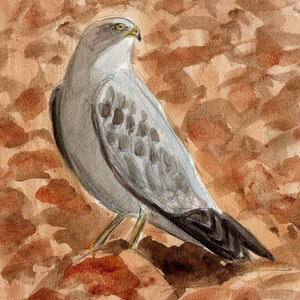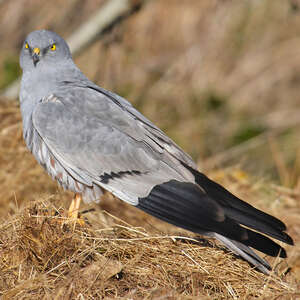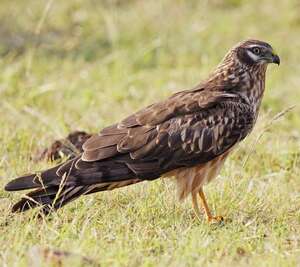Montagu's Harrier
Circus pygargus - Busard cendré
Identification
Montagu's Harrier is a slender, delicate harrier, the smallest and most svelte of the three nesting in Western Europe and roughly the same size as the more eastern Pallid Harrier. As is the rule with harriers, sexual dimorphism is great, and the young bird looks like its mother.
The adult male at rest is mostly ash-grey with black tips to the wings. Seen poorly, he could be mistaken for another grey harrier - but seen well he shows darker grey that extends to the breast, and particularly orange-brown flecking of the belly. Viewed from above in flight, this is easier - with a diagnostic black bar at the base of very pale secondaries, and white at the rump. Underneath, a mainly black hand with the secondaries conspicuously barred, and patches of rufous on body and coverts, all very typical. In comparison, the sympatric adult male Marsh Harrier is tricoloured, pale grey, white and black, without wing bars or marks.
The adult female 'ashy' is of a medium brown on the upperparts with a pale patch on the uppertail coverts and two pale patches on the front of the wing. The head is brown mottled with russet, two small pale patches either side - one forming an eyebrow, the other beneath the eye, both outlined at the back by a darker brown arch. The underparts are rufous of a variable intensity, with longitudinal brown spots. The undersides of wing and tail recall the male, but with a different background tone and crucially no black primaries on the hand which is pale, barred brown at the base of the secondaries.
The juvenile is similar to the female, but more dark brown above with more contrasted uppertail coverts and a tail barred rufous. The head is more contrasted too, with brighter white and brown patches, andThe lower parts are distinctly rufous and almost uniformly coloured. The secondaries are clearly darkening, forming two dark zones on either side of the body.
Be careful of confusing female and immature Montagu's Harriers. There is a great deal of similarity and it can be very tricky to accurately identify them in the field.
Subspecific information monotypic species
Foreign names
- Busard cendré,
- Aguilucho cenizo,
- águia-caçadeira,
- Wiesenweihe,
- hamvas rétihéja,
- Grauwe Kiekendief,
- Albanella minore,
- ängshök,
- Enghauk,
- kaňa popolavá,
- moták lužní,
- Hedehøg,
- niittysuohaukka,
- Bloupaddavreter (Blouvleivalk),
- arpella cendrosa,
- Gráheiðir,
- błotniak łąkowy,
- pļavu lija,
- močvirski lunj,
- Луговой лунь,
- ヒメハイイロチュウヒ,
- 乌灰鹞,
- ängshök,
- 烏灰鷂,
Voice song and call
Several different calls can be heard. The simplest is a buzzard type call, but shorter, sharper, and more acerbic. From an anxious bird in flight, one can expect short, repeated kiek kiek kiek cries. If the anxiety increases, they accelerate their cries to kie kie kie kie kie kie kie... becoming even more piercing.
The fledglings beg persistently with high pitched pjiiiiiiiiiuuhs.
Habitat
Birds of prey inhabit open habitats, mainly grassy but also lightly shrubby. Montagu's Harrier is no exception.
Behaviour character trait
On breeding grounds, Montagu's Harrier is not a gregarious bird. Simply, in areas that are favourable - such as those rich in rodent prey - territories can diminish in size and touch without us being able to speak of an colonial disposition of nesting sites.
It is in those conditions that we realise the peaceful nature of this species: even whilst territorial, it can support a high density of nesting couples without conflict between neighbouring ones.In wintering grounds, territoriality is reduced and large gatherings of Montagu's Harriers in nocturnal dormitories can be observed.
A particular behavioural trait which is particularly spectacular is the passing of prey in flight from the male to the female. The male who has captured a prey returns to the nest, which he overflies. Upon its sighting, the female takes off from the nest and then chases the male, who quickly goes away. When he deems the optimal distance has been reached between him and his female, he drops the prey which is quickly snatched by the female throwing her leg towards it after having performed a body-roll. After that, she returns peacefully to the nest, while the male goes off hunting once more.
Flight
As a great transcontinental migrant, the Montagu's Harrier is obviously well adapted to flight and to sustained flight over time.
It is only to look at its silhouette and its ease in the air. Among our raptors, it has the lowest wing loading at only 0.2 g/cm². This capacity is very useful to it when it is a matter of travelling 200 or 300 kilometres with a single flap of its wings, of hunting for quarry on the ground from high up, to then hand the spoils over to its mate while flying, or of chasing an intruder away from its territory.It is also a virtuoso of aerobatics when it comes to the formation or reunion of couples in springtime. Spectacular nuptial displays of dives, stalls and other glides are observed above the territory.
Dietfeeding habits
Given its modest size and method of movement, a slow and low flying over its hunting grounds, Montagu's Harrier mainly feeds on small mammals, primarily voles, but also terrestrial passerines such as larks, buntings, pipits taken by surprise, small reptiles such as lizards and large insects.
On rare occasions, if the opportunity arises, it may attack larger prey such as partridges, pheasants, rabbits and even young hares. But these remain marginal cases. In fact, discrepancies in its diet are related more to the characteristics and capacities of its hunting grounds and the condition of its prey populations.Reproduction nesting
Montagu's Harrier is able to reproduce at two years of age, more rarely at three and even more rarely at one.
Generally, couples form for life and thus partners rejoin their nesting territory from one year to the next. However, it rarely happens that there is a change of partner without death. Cases of polygamy are also mentioned.Installation takes place in April-early May. The installed couple performs a complex and rather similar nuptial parade to that of the Reed Warbler. This is how the partners strengthen the links that unite them. The two birds fly together in circles high in the sky, can exchange food, and then begin their spectacular aerial demonstration, chaining barrels, stunts, somersaults, dives and spread wings, punctuated by cries.
May is here and nesting follows quickly. The couple builds on the ground, in the heart of a favorable agricultural plot, a rather summary nest made of vegetal elements placed together forming a shallow central cup. The female lays 3 to 5 eggs, laid at intervals of 2 days on average, which she will incubate for about 5 weeks, each egg requiring 28-29 days of incubation. The chicks are covered with a rather comic gray-white fuzz. They are fed by their mother, the male being tasked with the supply. Young Harriers are able to leave the nest by walking at three weeks but flight is only possible at the age of 35 or 40 days. They will start hunting by themselves 2 to 3 weeks later. We are now at the end of June.
Geographic range
Montagu's Harrier is essentially a bird of the western Palearctic, only slightly crossing into north Africa's Maghreb. It breeds at middle latitudes, from the Atlantic coast to eastern Kazakhstan and a bit to the northwest of China. It is very rare in Great Britain. It is also rare around the Baltic where it reaches the Gulf of Finland, its northernmost point. The southernmost points of its range are the Maghreb, Turkey, northern Iran, and Uzbekistan.
It is a great migrant, with a totally disjoint wintering range. During this season, it is found in a sub-Saharan belt from the Atlantic coast (Senegal-Gambia) to the Red Sea and the Gulf of Aden (Ethiopia, Somalia) even crossing into Yemen in the south of the Arabian Peninsula. Its wintering range also extends into southeastern Africa as far as South Africa. The easternmost population winters in the south of the Indian subcontinent (Pakistan, southern India, Sri Lanka).
Threats - protection
IUCN conservation status
concern
in the Wild
threatened
evaluated
With global populations declining in recent years, the Montagu's Harrier is no exception. In France, they now mainly nest in cereal grains. When they arrive in the spring months of April, they choose to nest in fields with cereal that have already developed, providing enough cover for the nest. The problem arises when cereals are harvested prematurely, before the young birds are capable of flight. Without protection, they are at risk of perishing. Local associations often work to provide protection to these young Montagu's Harriers in cereal grains. Not to mention the potential dangers of their migration and wintering in sub-Saharan Africa.
Sources of information
- IOC World Bird List (v15.1), Gill, F and D Donsker (Eds). 2025-12-07.
Other sources of interest
 Specification sheet created on
22/07/2023 by Jean François
Specification sheet created on
22/07/2023 by Jean FrançoisTranslation by AI Oiseaux.net
© 1996-2025 Oiseaux.net
- Accipitriformes
- Aegotheliformes
- Anseriformes
- Apodiformes
- Apterygiformes
- Bucerotiformes
- Caprimulgiformes
- Cariamiformes
- Casuariiformes
- Charadriiformes
- Ciconiiformes
- Coliiformes
- Columbiformes
- Coraciiformes
- Cuculiformes
- Eurypygiformes
- Falconiformes
- Galliformes
- Gaviiformes
- Gruiformes
- Leptosomiformes
- Mesitornithiformes
- Musophagiformes
- Nyctibiiformes
- Opisthocomiformes
- Otidiformes
- Passeriformes
- Pelecaniformes
- Phaethontiformes
- Phoenicopteriformes
- Piciformes
- Podargiformes
- Podicipediformes
- Procellariiformes
- Psittaciformes
- Pterocliformes
- Rheiformes
- Sphenisciformes
- Steatornithiformes
- Strigiformes
- Struthioniformes
- Suliformes
- Tinamiformes
- Trogoniformes

































